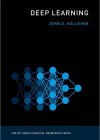Deep Learning (The MIT Press Essential Knowledge series)
John D. Kelleher (2019)

Deep learning is enabling innovation and change across all aspects of our modern lives. Most of the artificial intelligence breakthroughs that you hear about in the media are based on deep learning. As a result, whether you are a business person interested in improving the efficiency of your organization, a policymaker concerned with ethics and privacy in a Big Data world, a researcher working with complex data, or a curious citizen who wants a better sense of the potential of artificial intelligence and how it will change your life, it is important for you to have an understanding of deep learning. The goal of this book is to enable the general reader to gain an understanding of what deep learning is, where it has come from, how it works, what it makes possible (and what it doesn’t), and how the field is likely to develop in the next ten years. The fact that deep learning is a set of algorithms and models means that understanding deep learning requires understanding how these algorithms and models process data. As a result, this book is not purely descriptive and definitional; it also includes explanations of algorithms. I have attempted to present the technical material in an accessible way. From my teaching experience, I have found that for technical topics the most x PREFACE accessible presentation is to explain the fundamental concepts in a step-by-step manner. So, although I have tried to keep the mathematical content to a minimum, where I felt it was necessary to include it I have endeavored to walk you through the mathematical equations in as clear and direct a manner as I can. I have supplemented these explanations with examples and illustrations. What is really wondrous about deep learning is not the complexity of the math it is built on, but rather, that it can perform such a diverse set of exciting and impressive tasks using such simple calculations. Don’t be surprised to find yourself saying: “Is that all it’s doing?” In fact, a deep learning model really is just a lot (admittedly, an awful lot) of multiplications and additions with a few nonlinear mappings (which I will explain) added in. Yet, despite this simplicity, these models can, among other achievements, beat the Go world champion, define the state-of-the-art in computer vision and machine translation, and drive a car. This book is an introductory text about deep learning, but I hope that it is an introduction that has enough depth that you will come back to the book as your confidence with the material grows.
John D. Kelleher (2019)

Deep learning is enabling innovation and change across all aspects of our modern lives. Most of the artificial intelligence breakthroughs that you hear about in the media are based on deep learning. As a result, whether you are a business person interested in improving the efficiency of your organization, a policymaker concerned with ethics and privacy in a Big Data world, a researcher working with complex data, or a curious citizen who wants a better sense of the potential of artificial intelligence and how it will change your life, it is important for you to have an understanding of deep learning. The goal of this book is to enable the general reader to gain an understanding of what deep learning is, where it has come from, how it works, what it makes possible (and what it doesn’t), and how the field is likely to develop in the next ten years. The fact that deep learning is a set of algorithms and models means that understanding deep learning requires understanding how these algorithms and models process data. As a result, this book is not purely descriptive and definitional; it also includes explanations of algorithms. I have attempted to present the technical material in an accessible way. From my teaching experience, I have found that for technical topics the most x PREFACE accessible presentation is to explain the fundamental concepts in a step-by-step manner. So, although I have tried to keep the mathematical content to a minimum, where I felt it was necessary to include it I have endeavored to walk you through the mathematical equations in as clear and direct a manner as I can. I have supplemented these explanations with examples and illustrations. What is really wondrous about deep learning is not the complexity of the math it is built on, but rather, that it can perform such a diverse set of exciting and impressive tasks using such simple calculations. Don’t be surprised to find yourself saying: “Is that all it’s doing?” In fact, a deep learning model really is just a lot (admittedly, an awful lot) of multiplications and additions with a few nonlinear mappings (which I will explain) added in. Yet, despite this simplicity, these models can, among other achievements, beat the Go world champion, define the state-of-the-art in computer vision and machine translation, and drive a car. This book is an introductory text about deep learning, but I hope that it is an introduction that has enough depth that you will come back to the book as your confidence with the material grows.
Скрытое содержимое могут видеть только пользователи групп(ы): Premium, Местный, Свои
